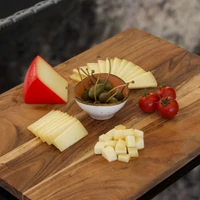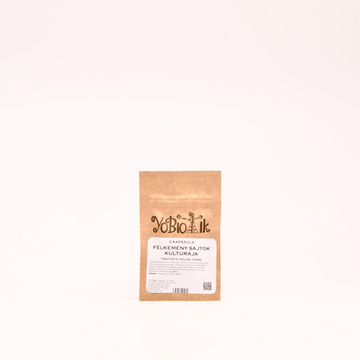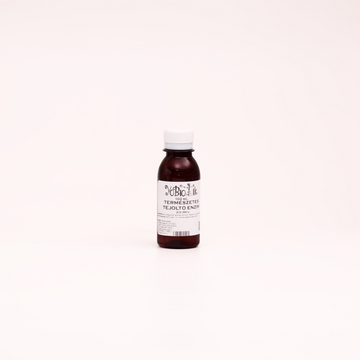The cheese was first made in XIII. century in the Netherlands, in the city of Gouda. Today it makes up 50-60% of the worlds cheese consumption.
Gouda is typically made from pasteurized milk, but there are some artisan cheesemakers that use goat or sheep's milk too. It is a semi-hard cheese, which texture is smooth, it's taste, depending on age, can be mellow or piquant. At this moment there is seven different Gouda categorised by age. Graskaas the young Gouda, which is aged for 2-4 weeks. Overjarig the old cheese, which is aged for several months. It tastes racy, very firm in texture, coloured yellow. The waxes colour gives information on the cheeses flavour. Red is natural Gouda, green is herb, yellow is cumin, black is extra mature 1 year old Gouda. The older the cheese the nuttier it is.
INGREDIENTS:
- 10 litres of milk
- 1 capsule Semi-Hard Cheese CapCulture
- 2 ml Natural Rennet 220 IMCU
- 1 capsule Lysozyme Enzyme
- Iodine free salt (cheese salt)
The recipe:
Use high quality fresh whole milk!
Pasteurisation: Pour the milk into a big pot and turn on your stove.
Heat it to 63-65 °C and keep it on that temperature for 30 minutes.
You can either put your pot in warm water, or use a termobox to keep it warm.
Then cool it back to 32 °C. Do that in a cold water bath.
1. CULTURING: Take the culture out of the fridge, pull it apart, and dissolve it in some lukewarm water.
Let it sit for 15-20 minutes, so the culture dissolves and comes to life.
At 32 °C, add 1 worth of culture for every 10 litres.
Let it rest for 10 -15 minutes.
During this period, at about halfway through, add 1 capsule of lysozyme enzyme, to prevent butyric acid related puffing.
2. COAGULATION: At 32 °C, add 2ml of natural rennet for every 10 litres of milk, and stir it well.
Cover the milk with a lid, and let it sour for 40-45 minutes, while keeping it on 32 °C.
At this pont do not heat, or stir the milk!
3. CUTTING THE CURD: Cut the now firm milk to 1,5-2 cm curds, with a cheese harp, under 8-10 minutes.
First cut the curd from two directions, wait 1-2 minutes, than continue cutting, until you get even curds.
4. SEDIMENTATION: Let the curds settle at the bottom of the pot for 10 minutes.
5. WASHING THE CURDS: Pour off 1/3 of the whey and and add as much 80 °C water, until it's evenly 34 °C.
Stir it constantly while doing so.
Let the it rest again for another 10 minutes. Ladle off as much whey that the curds become clearly visible.
Then add 80 °C water again, slowly, until you reach 38 °C.
Keep this temperature for 15 minutes. Gently stir the mixture, so the curds won't stick together.
Let it rest for another 10 minutes, so the curds shrink even more.
6. SHAPING: Pour off the remaining whey-water. Quickly put he curds into a cheese mould, so they won't cool down.
Be careful not to crush the curds, gently press them into the mould.
When all the curds are in the mould, put a follower onto it and weigh it down.
7. PRESSING: Start with 1x weight of the cheese. Gradually increase the weight, so the curds can stick together.
The flipping sequence: first flip after 10-15 minutes, increase the weight to 2x.
Flip again after 20-25 minutes, the weight should be 5x at this point.
After 30-40 flip again, double the weight, in other words use 10x the weight the cheese.
This is the final weight.
Press and flip the cheese for 16-18 hour altogether.
8. SALTING: Make a 20% brine, with 15-16 °C water. (to 200 g iodine free salt, add as much water, that the solution is 1000g)
Take the cheese out of the mould, and put it in a bowl big enough to contain it.
Add as much brine, that the cheese floats.
For every kilos, soak the cheese for 10-12 hours, flip it halfway through.
The brine, after straining, can be stored in a fridge, and reused 2-3 times. Boil it occasionally!
9. AGEING: Keep the cheese on a wooden board, flip it every day, so the surface dries out.
After 3-4 days, when it's nice and dry, cover the top and the side of the cheese with wax.
The wax will dry after 12 hours, flip the cheese and paint the other side too.
Repeat this step, so there is two layers of wax protecting the cheese.
I age the cheese for 4-6 weeks at 15-16° C, 80-85% humidity.
flip the cheese every day.
Age the cheese as long as you can. The longer you age it, the better the taste will be.
10. STORAGE: After cutting the cheese, keep it in a refrigerator, wrapped in wax paper.
Keep it at room temperature for 30 minutes before consumption, it tastes the best that way.
Happy cheesemaking! :D
 Lactic cultures
Lactic cultures
 Ingredients
Ingredients
 Cheese moulds
Cheese moulds
 Supplies
Supplies
 Kits
Kits




